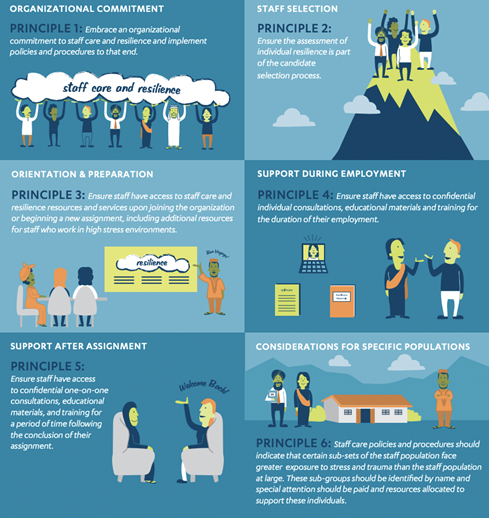
This piece was co-written with my colleague Raven Ellis, MA LCPC, Director of Clinical Operations at The KonTerra Group.
What word or phrase would you use to characterize the past year?
When we ask our clients this question, we hear words like change, upheaval, hard, painful, scary, and growth. And we hear a common thread — uncertainty. It has been a season of extraordinary instability and uncertainty for all of us — one filled with extra pressure, stress, and anxiety.
During times like this, it is tempting to put self and staff care on hold and to think that they can wait until things feel less overwhelming and uncertain. But it is precisely when things feel uncertain and overwhelming that it is most important to think about what we’re doing to manage our own stress and build resilience. As a leader, particularly within the humanitarian and development sector, prioritizing staff care is even more critical as your team is both responding to and experiencing the impacts of crises.
But how? And where can we even start?

Here are some examples of how we have seen organizations and leaders — including leaders who are GELI constituents — support their teams since the COVID-19 pandemic started.
1. Leaders have talked about the importance of psychological health and shared their own experiences
Leaders in numerous organizations have set good examples, created a culture of greater openness and support, and helped destigmatize mental health challenges by speaking to their staff about the importance of psychological health and sharing some of their own experiences.
2. Leaders have communicated with their teams regularly — with specificity, understanding, and appreciation
We were all hungry for information during 2020 and into 2021, and that is not surprising. In times of uncertainty, the lack of information and a story is often perceived as threatening. As such, organizations and leaders can help reduce that sense of threat by frequently communicating with specificity and compassion. In multiple organizations, we have observed executive leadership teams and managers communicating regularly with staff to:
- Acknowledge that everyone is facing extra pressures, demands, and responsibilities.
- Express their support and appreciation for staff efforts.
- Clarify priorities and work-related expectations and allay a sense of work-related pressure and insecurity wherever possible.
3. Leaders have identified resources (financial and non-financial) that could be mobilized to support their teams
Leaders have acted to identify and make multiple resources available to support staff. For example, they have:
- Reminded staff about Employee Assistance Program or Employee Resilience Program resources and how to access them (or made some counseling available at no cost to employees).
- Distributed and discussed free resources, including tip sheets, reputable health briefings, and relevant podcasts.
- Granted extra caregiving leave to enable staff to manage additional responsibilities (such as overseeing children completing virtual schooling).
- Granted additional paid sick leave and leave to receive (and recover from) vaccinations.
4. Leaders have devoted time to exploring important topical issues in ways that help their teams make decisions or learn/grow
Leaders have spent time, energy, and resources (by hiring external facilitators and advisors and organizing discussion forums, groups, briefings, and workshops) to help enable staff to:
- Learn more about potential risks to physical and psychological safety and make informed choices on those issues (e.g., briefing staff on the research regarding COVID-19 transmission, vaccination).
- Explore matters related to race, gender, culture, and marginalized identities.
- Connect around grief or other concerns related to critical incidents or the death(s) of staff members.
5. Leaders have made additional training available on issues related to staff care, stress, and resilience
Leaders have made training on stress and resilience available. Topics organizations have made available to staff facing different challenges around the world include:
- Effective self-care for managing stress and building resilience
- Supporting your team effectively during a crisis
- Psychological PPE for frontline healthcare workers
- Managing anxiety and coping with isolation
- Understanding and coping with burnout and vicarious trauma
- How managers can help prevent burnout and vicarious trauma
Questions for you
If you are a leader, here are some questions for you to consider as you seek to care for your team during this (and future) seasons of extreme upheaval and uncertainty. You may want to discuss these questions with your leadership team and/or those you supervise:
- How have you seen the Essential Principles of Staff Care applied within your organization since the COVID-19 pandemic began?
- Which principle do you think your organization/manager is naturally “strongest” in? What about “weakest”?
- What would you like to be different in your organization (or for your team) related to staff care a year from now?
- What are three actions you can take in relation to each principle that would improve staff care within your organization/team?
To access free resources on stress and resilience, you can visit www.konterragroup.net.






